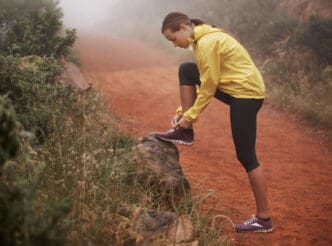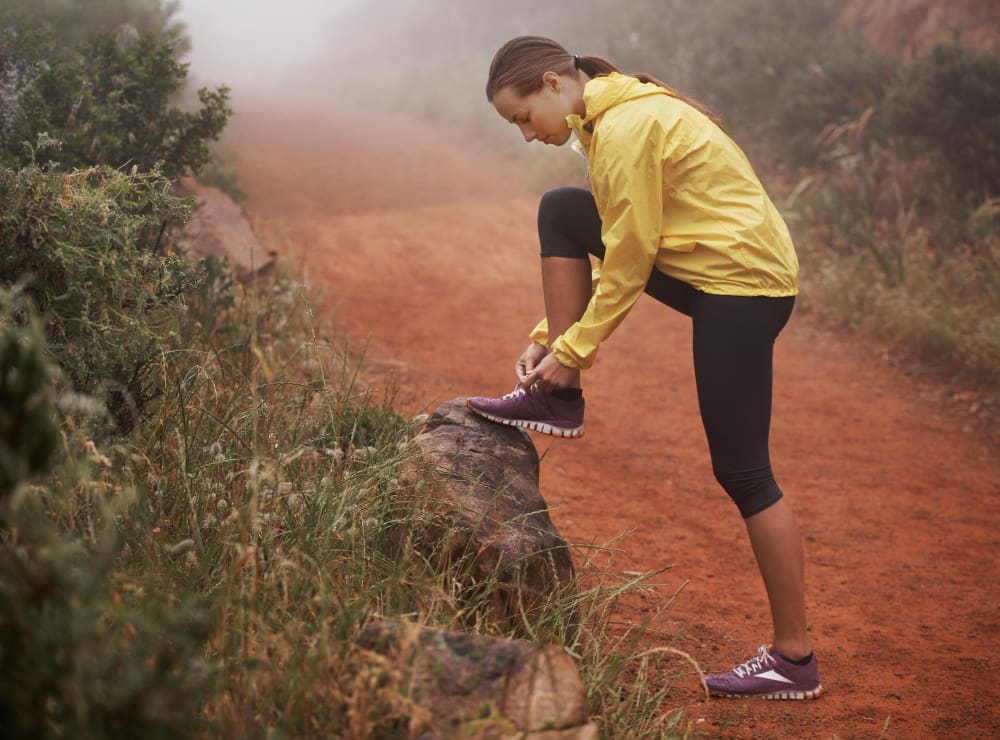For any runner looking to trade pavement for the unpredictable beauty of nature, the single most important piece of gear is the trail running shoe. Unlike their road-running counterparts, these specialized shoes are engineered to provide the essential grip, stability, and protection needed to safely navigate everything from groomed park paths to technical, rocky mountain ascents. Choosing the right pair is a critical decision that directly impacts performance, prevents injury, and unlocks the confidence to explore off-road terrain. The key to finding the perfect shoe lies not in a brand name, but in a thoughtful assessment of the primary terrain you will run on, ensuring the shoe’s features are perfectly matched to the demands of the ground beneath your feet.
What Makes a Trail Shoe Different from a Road Shoe?
At first glance, a trail shoe might just look like a more rugged running shoe, but the differences are profound and purpose-driven. Each modification is a direct response to the challenges of running on uneven and varied surfaces.
Aggressive Outsoles for Superior Grip
The most noticeable difference is the outsole—the part of the shoe that contacts the ground. Road shoes have relatively flat, durable rubber designed for consistent traction on asphalt or concrete. Trail shoes, however, feature deep, pronounced patterns called lugs.
These lugs act like cleats, digging into soft surfaces like dirt, mud, and grass to provide reliable grip. The depth and spacing of these lugs vary; deeper, more widely spaced lugs are ideal for shedding mud, while smaller, multi-directional lugs offer versatile traction on hard-packed dirt and rock.
Enhanced Protection and Durability
Trails are littered with potential hazards like sharp rocks, stray roots, and abrasive debris. To shield your feet, trail shoes incorporate protective features absent in road shoes. Many models include a rock plate, which is a thin, semi-rigid layer of plastic or carbon fiber embedded in the midsole to prevent sharp objects from bruising the bottom of your foot.
The uppers are also built for abuse, often using tightly woven, synthetic mesh with durable overlays (typically TPU, or thermoplastic polyurethane) in high-wear areas. A reinforced toe cap, or toe bumper, is a standard feature that protects your toes from painful impacts with rocks and roots.
Increased Stability and Support
Running on an uneven surface constantly challenges your balance. Trail shoes are designed to create a more stable platform to reduce the risk of ankle rolls. They often feature a firmer midsole and a more structured heel counter to lock your foot in place.
Furthermore, many trail shoes have a lower stack height (the amount of material between your foot and the ground) compared to highly cushioned road shoes. This brings you closer to the ground, lowering your center of gravity and improving your proprioception—your sense of the ground beneath you—which enhances stability and reaction time.
Decoding Your Terrain: Matching the Shoe to the Surface
The term “trail” encompasses a vast range of surfaces. The key to satisfaction with your purchase is to honestly evaluate where you will be doing the majority of your running and choose a shoe built for that environment.
Light Trails and Groomed Paths
This category includes well-maintained dirt paths, fire roads, gravel trails, and manicured park loops. These surfaces are relatively predictable and free of major obstacles. For this type of running, a “door-to-trail” or hybrid shoe is an excellent choice.
These shoes offer a blend of road and trail features. They typically have moderate cushioning for comfort, a flexible design that feels responsive on harder surfaces, and less aggressive lugs (usually 2-4mm deep) that provide adequate grip on dirt without feeling clunky on stretches of pavement.
Technical and Rocky Terrain
If your runs involve navigating singletrack littered with rocks, roots, and steep, uneven grades, you need a shoe designed for technical terrain. These conditions demand maximum protection, grip, and a secure fit to prevent your foot from sliding inside the shoe on ascents and descents.
Look for shoes with deep, aggressive lugs (5mm or more) made from a sticky rubber compound for superior grip on both wet and dry rock. A prominent rock plate is non-negotiable for underfoot protection. The fit should be snug and secure, especially in the midfoot and heel, to give you confidence in your foot placement.
Mud, Soft Ground, and Wet Conditions
For runners in perpetually damp climates or those who love tackling boggy, soft ground, a specialized shoe is essential. Standard trail shoes can quickly become clogged with mud, transforming into heavy, slippery weights on your feet.
Shoes designed for mud feature exceptionally deep, widely spaced lugs. This design allows them to penetrate deep into the soft ground for traction while effectively shedding mud with each step so the outsole remains clear. These shoes often have a snug, almost sock-like fit and a durable, water-resistant upper to keep debris out.
Hard-Packed and Dry Trails
In arid environments or during dry summer months, trails can become hard-packed and fast. While less technical, these surfaces can be abrasive and demand a combination of cushioning, breathability, and versatile traction.
For these conditions, an all-around trail shoe works best. Look for models with shorter, multi-directional lugs that provide grip without being overly aggressive. Prioritize a breathable upper to keep your feet cool, and consider a moderate amount of cushioning to absorb impact over long miles on the firm ground.
Key Features to Consider When Buying Trail Shoes
Beyond terrain, a few key technical specifications will influence how a shoe feels and performs for you. Understanding them will help you narrow down your options.
Cushioning: Maximalist vs. Minimalist
The amount of foam in the midsole determines the shoe’s cushioning. This exists on a spectrum. Maximalist shoes feature thick, plush midsoles that provide exceptional shock absorption, making them ideal for ultra-marathoners or runners who prioritize comfort over long distances.
On the other end, minimalist shoes have very little cushioning, promoting a natural foot motion and excellent ground feel. Most runners will find their sweet spot with a shoe offering moderate cushioning, which provides a balance of comfort, protection, and responsiveness.
Heel-to-Toe Drop
Drop refers to the difference in height between the heel and the forefoot of the shoe, measured in millimeters. A high drop (8-12mm) is typical of traditional running shoes and tends to favor a heel-striking gait. A low or zero drop (0-4mm) places the foot in a more level position, which can encourage a midfoot or forefoot strike.
There is no “correct” drop; it is a matter of personal preference and running biomechanics. If you are new to trail running, starting with a drop similar to your road shoes is a safe bet. If you wish to transition to a lower drop, do so gradually to allow your lower leg muscles and Achilles tendon to adapt.
The Waterproof Debate: GORE-TEX (GTX) vs. Non-Waterproof
Many trail shoes are offered in two versions: a standard, breathable model and a waterproof version, often using a GORE-TEX (GTX) membrane. A GTX shoe is excellent at keeping your feet dry from external moisture like rain, dew-covered grass, and shallow puddles.
However, this waterproofing comes at the cost of breathability, meaning your feet will get warmer and sweat more. More importantly, if water does get inside the shoe—for example, during a deep creek crossing—it becomes trapped and the shoe will be very slow to dry. For most runners, a non-waterproof shoe with a mesh upper that drains quickly and breathes well is the more versatile choice, especially in warmer climates.
Fit and Sizing
This is, without question, the most critical factor. A poorly fitting shoe, no matter how technologically advanced, will lead to blisters, discomfort, and even injury. Always try on shoes at the end of the day when your feet are slightly swollen. Wear the same type of socks you run in.
You should have about a thumb’s width of space between your longest toe and the end of the shoe. The fit should be secure and locked-in around your heel and midfoot to prevent sliding, but there should be ample room in the toe box for your toes to splay naturally upon impact.
Conclusion
Investing in the right trail running shoe is an investment in your safety, comfort, and overall enjoyment of the sport. By moving beyond brand loyalty and focusing instead on the specific demands of your chosen terrain, you can make an informed decision. Analyze the surfaces you’ll encounter, consider your preferences for cushioning and other features, and above all, prioritize a perfect fit. With the right pair of shoes on your feet, you will be well-equipped to confidently and joyfully answer the call of the trail.







